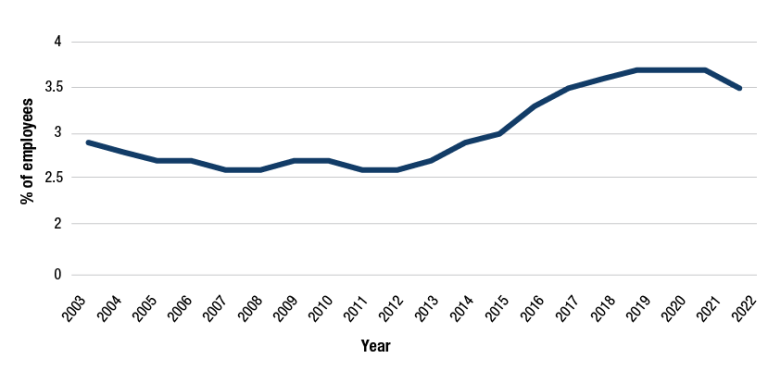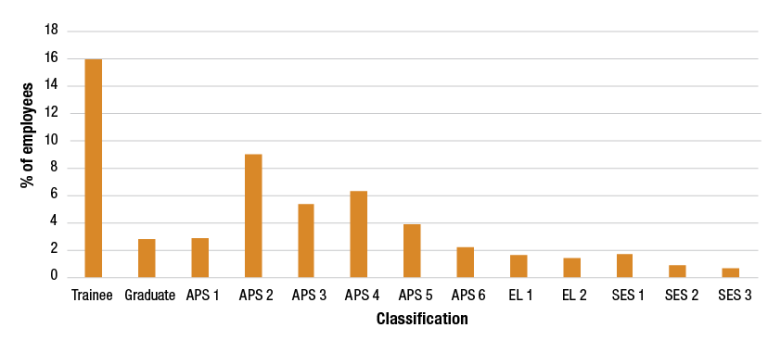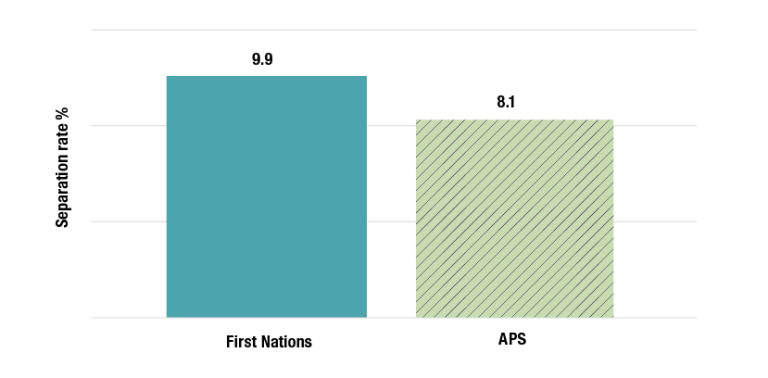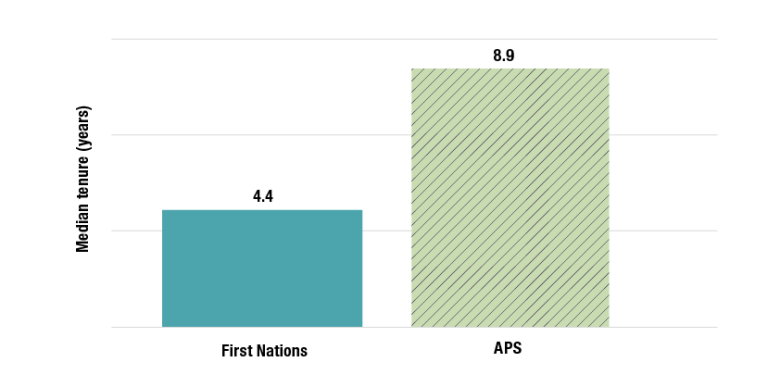2.2 First Nations Peoples
Closing the Gap Priority Reform 3, Transforming Government Organisations, seeks to ensure governments are culturally safe and responsive to the needs of Aboriginal and Torres Strait Islander peoples.
As an employer, it is crucial the APS has strong First Nations representation at every level. It is essential that the APS benefits from the cultural perspectives of First Nations Australians, particularly given the important role the APS plays in Closing the Gap and working in genuine partnership with First Nations Australians.
Cultural competency is one essential component of this, and the APS is working to improve cultural understanding and better recognise the skills and perspectives First Nations peoples bring. A focus on building community partnerships and involving First Nations Australians in decision-making works on many fronts. It builds community capability and APS cultural capability. It also harnesses diversity to solve problems.
Through the Commonwealth Aboriginal and Torres Strait Islander Workforce Strategy 2020–24, the APS also seeks to improve employment outcomes for First Nations employees through three core focus areas: cultural integrity; career pathways; and career development and advancement (Figure 2.2). Despite this, the APS is not on track to meet its targets for First Nations peoples to be in leadership positions. Moreover, the Albanese Government has set a target of 5% for First Nations representation in the APS by 2030. Significant further work will be required by APS agencies to ensure these targets will be realised.
A mid-point review of the strategy is underway to support a refocus of actions and activities across the APS. Rethinking employment location strategies, improving career pathways and greater mentoring and development will be important.
Figure 2.2: Commonwealth Aboriginal and Torres Strait Islander Workforce Strategy 2020–24

Source: Commonwealth Aboriginal and Torres Strait Islander Workforce Strategy 2020–24
As at 30 June 2021, First Nations Australians represented 3.8% of the Australian population.[13] In the APS, First Nations representation levels remained steady from 2003 to 2022 and represented 3.5% of the workforce in 2022 (Figure 2.3). Behind this data, issues presenting challenges for the APS are: concentration of First Nations employees in lower classification levels (Figure 2.4); high separation rates (Figure 2.5); and shorter APS careers (Figure 2.6).
Figure 2.3: Proportion of First Nations employees (2003 to 2022)

Source: APSED
Figure 2.4: Proportions of First Nations employees by classification (30 June 2022)

Source: APSED
Figure 2.5: Separation rate of First Nations employees compared to all APS (30 June 2022)

Source: APSED
Figure 2.6: Median length of service at separation for First Nations employees compared to all APS (30 June 2022)

Source: APSED
Cultural integrity
Creating culturally safe workplaces and embedding an understanding of First Nations culture is vital to attracting and retaining First Nations employees in the APS and achieving Closing the Gap Priority Reform 3. The APSC has worked with First Nations employees and the National Indigenous Australians Agency (NIAA) to deliver support and practical guidance to uplift workforce cultural capability. The APS Academy provides dedicated learning to improve cultural capability among APS employees. The Aboriginal and Torres Strait Islander Cultural Capability: A Framework for Commonwealth Agencies is under review and resources to assist agencies to improve the cultural capability of their workforces, under development, are to be released in late 2022.
| Footprints Program - National Indigenous Australians Agency | ||
|---|---|---|
| The NIAA Footprints Cultural Learning Program aims to cultivate knowledge and understanding within the agency, by promoting an inclusive workplace where staff can bring their whole selves to work. Staff participate in a range of bespoke activities (books, movies, podcasts and exhibitions) to learn about cultural backgrounds, including First Nations peoples, cultures, lands and histories. | ||
| Footprints encourages staff to take responsibility for their learning journey through a ‘choose your own adventure’ approach to learning, led by their own curiosity. Post-activity reflections help embed the learning as does sharing their learning experience with others. Linked to the performance management cycle, conversations on knowledge and learning are a regular feature of the Footprints Program. In 2022, the program was announced as a runner up for the Institute of Public Administration Australia (IPAA) 2021 Spirit of Service Awards, learning category. The next step for Footprints includes developing a toolkit to share with other workplaces interested in implementing the program. |
||
| Commonwealth Indigenous Rangers Program - National Indigenous Australians Agency | ||
|---|---|---|
|
(Western Arnhem Land) (Image: NIAA) |
The Commonwealth Indigenous Rangers Program, managed by the NIAA, recognises the expertise of First Nations peoples in caring for Country. Organisations are funded through competitive grant rounds to deliver Indigenous ranger programs that connect with and care for Country. This assists First Nations peoples to maintain Traditional obligations at the heart of their culture. It also provides communities with opportunities for employment, economic development and environmental management. | |
| As at 30 June 2022, ranger organisations supported around 1,900 full-time, part-time and casual jobs through 128 Indigenous ranger groups across Australia. Approximately 86% of full-time equivalent positions had been filled by First Nations peoples and measures put in place through funding agreements to increase this proportion through transition planning. About one-third of ranger jobs were filled by women. | ||
| In 2021, the Australian Government approved more than $746 million to extend the Indigenous Rangers Program to 2028. This funding security will help Indigenous ranger groups undertake longer-term planning to manage Country. Another commitment by the Government is to double the number of Indigenous rangers by the end of the decade. Additional funding will expand existing ranger groups, create new ones, increase the number of women rangers, build further capacity in the First Nations land and water management sector, and create additional pathways for youth ranger programs. | ||
| Traditional Owners and community members play a key role in local project design, development, implementation and leadership. This aligns outcomes with the needs and interests of the community and the local environment. It also empowers ranger groups and communities to develop partnerships with research, education, philanthropic and commercial organisations. These partnerships support sharing skills and knowledge, engaging with schools, and generating additional income and jobs in environmental, biosecurity, heritage and other sectors. | ||
| Rangers report they feel more pride, self-worth, health and wellbeing. They also report having closer connections to family, culture and Country. Ranger groups point to a wide range of community benefits from the program. These include safer communities, strengthened language and culture, an ability to find meaningful employment, increased respect for women, and more role models for younger people. | ||
| In August 2022, the Minister for Indigenous Australians, the Hon Linda Burney MP, and the Minister for the Environment and Water, the Hon Tanya Plibersek MP, acknowledged the work of the program in protecting land and sea Country for the benefit of all Australians by launching Stories from Country 2022. | ||
| Minister Burney said that the Indigenous rangers deliver ‘ecological and cultural outcomes as well as creating meaningful and culturally appropriate employment and career pathways for First Nations peoples.’ | ||

|
Find out more about the Indigenous Rangers program |
Career Pathways
Under the Commonwealth Aboriginal and Torres Strait Islander Workforce Strategy 2020–24, work to date has focused on entry level pathways, such as graduate programs, rather than retention and/or recruitment into more senior roles.
The focus on junior roles, coupled with high separation rates, has likely contributed to low representation of First Nations Australians at middle and senior levels of the APS.
In a tight labour market with strong competition from all sectors for First Nations talent, career development and advancement offerings are vital in attracting and retaining First Nations employees. To build greater representation in senior ranks, the APS is exploring opportunities for a targeted SES recruitment and retention program with ongoing career development for First Nations SES.
The APS recognises that the geographic work location of First Nation employees may impact on career advancement.[14] The APS Location Strategy, being developed as an initiative of the Future of Work Sub-committee, finds that the APS has been Canberra-centric in its recruitment. The Sub-committee is exploring options to locate staff closer to local communities (more information on the Location Strategy is in Chapter 7). Offering more opportunities in regional locations such as Darwin, the four APS Academy campuses established from 2023 will enable fulfilling careers in the APS where people can continue to stay close to where they have built their lives.
Affirmative Measures recruitment is one way the APS brings First Nations peoples into the workforce. Over the past year the number of positions advertised using Affirmative Measures increased from 110 in 2019–20 to 477 in 2021–22, including more positions advertised at senior levels. Despite this, and targeted campaigns by some agencies, this approach has not translated into significant change in the overall proportion of First Nations peoples in the APS workforce. This suggests more effort is required on the APS’s employee value proposition for First Nations peoples, the recruitment processes involved and the capability of managers and human resource professionals. The launch of an Affirmative Measure Hub is one example of work undertaken over the past year to strengthen APS's ability to attract and recruit First Nations Australians.
| Helping agencies recruit First Nations Australians - Affirmative Measure Recruitment Hub | ||
| The APSC launched the Affirmative Measure Recruitment Hub in July 2022 to support greater inclusivity in the workforce. The hub is a GovTeams page for everyone involved in recruiting and on-boarding First Nations staff. It provides an end-to-end suite of guidance, tools and resources to assist agencies in recruiting First Nations talent in a culturally safe way. | ||
|
The guidance is designed to supplement and complement agency recruitment processes.The hub includes:
|
||
| The Aboriginal and Torres Strait Islander Employee Value Proposition: A Tool for Recruiters contains templates and suggesting wording, hints and checklists to help agencies create compelling recruitment campaigns specific to them and their vacancies. It is one of the significant resources housed on the hub. | ||
| The Affirmative Measure Recruitment Hub is the result of a collaborative project run by the APSC’s Inclusion Group. This group works with other teams across the APSC and APS to support a diverse, inclusive workforce. The hub is the key output of the six-month, cross-agency Affirmative Measure Indigenous Recruitment project, which involved 23 agencies. | ||
| Any Australian Government employee can access the hub. To do so, employees email diversity@apsc.gov.au |
Jawun program
APS employees benefit when they can engage directly with First Nations communities, while contributing their skills to practical activities that build greater inclusion.
Jawun is a not-for-profit organisation placing people from corporate and government organisations into Indigenous communities in 12 regions across Australia. Commonwealth government agencies have been participating in the Jawun APS Secondment Program since 2011, facilitating more than 700 APS employees to live and work in Indigenous communities across Australia.
The primary purpose of these secondments is to contribute to the capacity of Indigenous organisations through skill and knowledge transfer. APS secondees also bring Jawun experience back to their agencies, positioning them to help drive cultural change.
To better leverage secondee learnings and relationships gained through Jawun to further Closing the Gap priority reforms, the APS is working closely with Jawun to expand the program. This includes:
- increasing the total number of secondees by broadening the secondment target group to include APS 6 through to SES
- considering different secondment formats, such as longer secondments or small team secondments
- developing a strong and active alumni of Jawun secondees to support cultural change in the APS.
Footnotes
[13] ABS (Australian Bureau of Statistics), Estimates of Aboriginal and Torres Strait Islander Australians, 21 September 2022.
[14] APSC Research Note 11–22.



